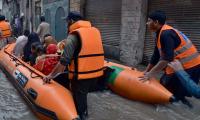The prime minister correctly says “sawa do crore” (22.5 million) Pakistani children of school-going age (five to 16) are not in school. This important statistic needs to be seen in context: these are nearly half of Pakistan’s 51 million children of school-going age.
That’s quantity for you, but Pakistan’s schooling challenge has an equally important dimension: quality. The children who do go to school achieve such low educational attainment that many who finish eight to 10 years of schooling cannot do Math or read Urdu/English books for class-two students. Lack of schooling and low-quality schooling perpetuate poverty. Pakistani households led by an illiterate head of household are more likely to be poor and their poverty is more likely to be transferred to their next generation as well.
Four trains: In the 21st century, prosperity is linked to human productivity, which, in turn, is primarily linked to education and skills. A modern educational system has to be a train that takes citizens of all ages and backgrounds towards prosperity. Pakistan has not one but four different trains for this journey.
There is the elite bullet train that carries barely one percent of all school-age children but prepares them to compete internationally through the O and A level systems. Then, there is what can be called the English-medium private schools train which carries about 15 percent of school-age children. Only a small proportion of these schools comprise the expensive private schools that educated Pakistanis are familiar with. Most of them are likely to be one-room operations with a single teacher charging a few hundred rupees a month in a low-income urban area or a rural locality – with a local language mostly spoken during the ‘English period’.
Then comes the largest and most decrepit train, carrying a third of all school-age children: Urdu-medium government schools run by the provincial governments. These schools are free. However, parents often prefer to pay for their children to go to private schools rather than the free public-sector schools where teachers get the best pay but don’t need to perform.
We have accounted for a little over half of all school-age children. The rest are the ‘sawa dou crore’, some of whom never leave the train station. Most, though, are pulled off their train too early.
Government statistics separately report on the madressah train that is pulled by a steam engine. It has some five percent of all school-age children but impart skills that hardly prepare children to participate in the modern economy. Each train delivers its passenger at a different station in life and at different travel speeds. This is perhaps the greatest source of inequality among Pakistanis.
All aboard: Pakistan has increased its primary school enrolment. Government statistics report that above 90 percent children of primary-school age attend school. This enrolment rate wouldn’t have been possible if parents weren’t sending girls of primary-school age to school. The participation rate drops precipitously as children finish primary education: only a third of Pakistani children of secondary school age are in school. The drop is steeper for girls than it is for boys.
We need to understand the choices made by parents in poor families. Extensive World Bank surveys in Punjab have revealed that even uneducated parents are able to correctly gauge whether their children are learning or not, and which among them is smarter. The key determinants of their decisions about school choices are based not only on cost and quality, but also on the distance between the school and a child’s home. The walk to and from school can be unsafe, particularly for girls. Predictably, enrolment rates fall where schools are farther, even more for girls. Parents must be able to trust that it is worthwhile and safe to send their children to school. More secondary schools and safe school bus services are needed – particularly in rural areas.
Funding: Pakistan stands perennially low in terms of human development rankings – usually around 145 among 200 countries. The resources Pakistan devotes to human development help explain this ranking. For more than half of the countries in the world, expenditure on education is more than four percent of their GDP. Over a dozen of these countries spend more than seven percent of their GDP on education. Pakistan has traditionally spent below three percent. Most countries also spend over 15 percent of their annual government expenditure on education – just like the ‘Asian Tiger’ countries did in the 1970s and 1980s. Pakistan has generally spent below 13 percent.
How you spend it is equally important. Pakistan devotes about a third of its education budget to primary education, with a similar proportion going towards secondary education and the rest being attributed towards tertiary education. As a result, none of these tiers has enough funding to deliver high-quality education to all students.
By contrast, the ‘Asian Tigers’ devoted between 65 percent and 80 percent of their government education spending towards primary education. For example, South Korea decided early on that the government’s scarce resources must be focused on delivering the best primary education possible while the private sector was encouraged to invest in secondary and tertiary education. As a result, parents from poor families found their children to be so well prepared after primary school – for free – that they made every effort to pay for their education through private-sector secondary schooling, with a little help from government programmes where absolutely necessary. So, government, parents, and the private sector collaborated to make a world-class future for South Korean children.
Teachers make (or break) a child’s future. The global experience with school education tells us that outcomes depend on the magic that takes place in the classroom. And this magic emerges from the inspired performance of teachers. McKinsey, a global consultancy, studied the world’s best school systems – Finland and Singapore – and concluded that the key to their success are the painstaking, multi-stage processes that they follow to identify, filter, train, and certify teachers.
Teacher quality is more important than school facilities and IT. But not everyone is born to be a teacher. Pakistan needs a thorough and exacting teacher certification system – just like we have for other ‘respectable’ professionals, such as doctors and pilots.
For a student-teacher ratio of 25 to 1, Pakistan needs about two million schoolteachers for 51 million children of school-going age. According to government data, Pakistan has some 1.4 million schoolteachers. Again, quantity trumps quality here. The problem is that education sector jobs have traditionally been a favourite for political parties to reward workers and voters, the quality of education be damned. The key is to ensure the suitability and competence of teachers through a strong certification system.
School facilities are also far from adequate. This tragedy can be turned into an opportunity. Pakistan must start a massive school construction campaign by using the best designs and optimal local materials. This will generate economic growth and also build public-service assets. This is what Turkey did at the turn of the century.
Education ministry officials were able to secure the interest of Turkey’s entrenched construction industry to build schools. The result was a massive construction campaign, which added over 100,000 classrooms in new and old schools all over Turkey and 150,000 teachers/school inspectors, with $3 billion invested annually between 1997 and 2002 by all stakeholders.
Incentives for teachers to serve in rural areas were essential to the success of this programme. In Pakistan, the Punjab Education Foundation and the Sindh Education Foundation are positioned to conduct a highly visible programme of this kind. Where needed, IT can supplement learning.
Free lunch: Finally, let’s not forget Pakistan’s schoolchildren. Since permanent hunger and malnutrition is widespread in Pakistan, children who do go to school are often so hungry that they cannot focus on what is being taught. This is why a school-lunch programme must be mounted across the country. If the millions of school-going Pakistanis are served quality food for lunch every day at school, think of the impact this could have on our agricultural sector. Like school construction, this programme will cause multiple benefits and produce no regrets.
The writer advises on development policy and strategy.
Email: kazimsaeed0817@gmail.com
As usual, any such deal, aiming to resuscitate ailing economy, brings to fore urge and resolve to halt further...
A representational showing sticky notes on a board. — Unsplash/FileThere are some common themes from the lives...
Whether the Daanish Schools effort has been able to live up to its principles or not may be debatable
According to the federal government, last year 653,100 people experienced homelessness on a single night in America
Another advantage for Pakistan is the enhanced teledensity and internet penetration
Both media spheres need to dovetail in amplifying the urgency of addressing climate change at the local, national, and...







